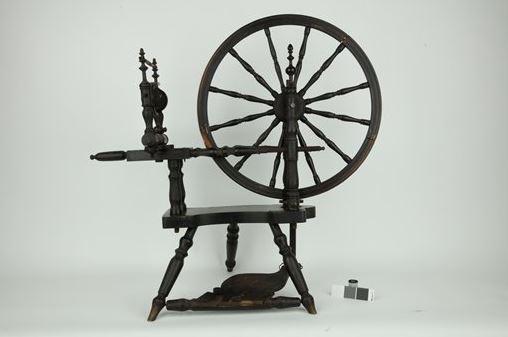Conservation of Miss Busby’s Spinning Wheel

Figure 1: Spinning Wheel before treatment. AWM2016.77.1.1.
This spinning wheel was owned and used by Miss Augusta Dora Merewether Busby, honorary secretary of the 19th Battalion Comforts Fund during the First World War.
The spinning wheel was recently donated to our National Collection by Miss Busby’s nephews, and was in need of great care and attention. In addition to grime and rust, the wheel was fragmented into over a dozen different pieces that had been detached, broken or lost entirely.
In preparation for storage, we in objects conservation began the process of documenting the physical condition and qualities of the spinning wheel. This included detailed photography of the different components and the damage to the wheel. In this process we discovered that the wheel had undergone several previous repairs, including old repairs to splits in the frame, replacement of the treadle, and replacement of a single wheel spoke. These were identified by differences in production techniques, as well as by inconsistencies in the surface finish.
We then explored our conservation treatment options to prepare the spinning wheel for storage. Our goal is to stabilise recent acquisitions so they can be safely stored for future research and display. During this process, we must consult with curators and decide whether particular damage shows evidence of an object’s history. For example, there were two types of dirt and grime on the spinning wheel. The top layer of loose dust and fibre was caused by years in storage. The layer beneath this was at least partially accumulated closer to the time of the spinning wheel’s use. Future analysis of this layer may yield information; it is also the source of the weathered and authentic aesthetic qualities we would expect from an object that has survived through the years. These signs of wear give us a sense of the object’s history, and should remain in place. This idea formed the basis of our conservation treatment.

Figure 2: Cleaning wheel with brush, vacuum and smoke sponge. AWM2016.77.1.1.

Figure 3: Table body and connecting rod guard before treatment (left) and after cleaning and corrosion treatment (right).

Figure 4: Wheel with replacement dowels before painting. AWM2016.77.1.1.
We decided to support the wheel by securing cotton tape around the rim. This option has the least immediate impact on the object, and will give us more options when it comes to future treatments and display. A barrier of Mylar (thin conservation-grade plastic (PET)) was inserted between the cotton tape and the wheel surface to reduce the tape making an impression in the paint over time. By securing the wheel rim and replacing the missing dowels, the wheel was unified as a stable whole. This was the most intensive part of the treatment, and contributed to the improved appearance of the wheel along with the subsequent re-fitting of the other components such as the bobbin and wheel shaft.
Finally, new appropriate housing was constructed to adequately support the wheel while in storage. This consisted of a large custom-made box constructed from archival corrugated cardboard and ethafoam, in which the spinning wheel components could be kept together. The associated yarn skeiner (also called a niddy noddy) was rehoused in a foam and Tyvek-lined folder secured to the floor of the box, to ensure it remained physically associated with the spinning wheel.

Figure 5: Wheel shown in custom box with cotton tape holding the rim secure. AWM2016.77.1.1.
Our process was well documented in our online collection database. Before permanent storage, the treatment of the spinning wheel and its changes in appearance were well documented in our records. The spinning wheel is now stabilised and fully prepared for storage. This treatment has also prepared minimised the treatment required when it will be selected for display in the near future.

Figure 6: Spinning wheel after treatment. AWM2016.77.1.1.